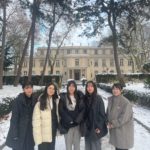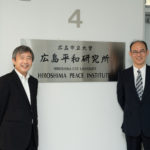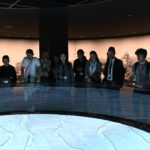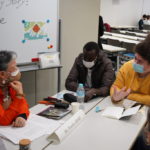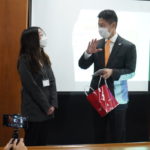Barbara Reynolds and World Friendship Center – An American Woman who Conveyed Hibakusha Voices to the World-
1 Barbara’s Journey
 Barbara Reynolds came to Hiroshima in 1951 with her husband, Earle Reynolds, and her children. Earle had been sent as part of a U.S. study team to the Atomic Bomb Casualty Commission (ABCC), now the R.E.R.F., charged with examining children exposed to radiation. Three years later Barbara, Earle, and two of their three children left Hiroshima with three young Japanese men on their newly launched yacht named “Phoenix of Hiroshima”.
Barbara Reynolds came to Hiroshima in 1951 with her husband, Earle Reynolds, and her children. Earle had been sent as part of a U.S. study team to the Atomic Bomb Casualty Commission (ABCC), now the R.E.R.F., charged with examining children exposed to radiation. Three years later Barbara, Earle, and two of their three children left Hiroshima with three young Japanese men on their newly launched yacht named “Phoenix of Hiroshima”.
Traveling around the world in their yacht had been Earle’s lifelong dream. As they traveled, the family’s interest in world peace developed. The people they met asked questions of their Japanese crewmen about the aftereffects of the Atomic bomb. The Reynolds learned more as they listened. They did not know much about the A-bombing because they lived in Rainbow Village, a military base in Kure, where they met only a few Japanese.
When they visited Hawaii, they met four Quakers who were protesting against nuclear testing in the South Pacific. Their yacht, “The Golden Rule”, sailed into the “forbidden zone” where the testing was being done. With a sense of mission, Barbara and her family decided to protest by sailing to the “forbidden zone” themselves. This resulted in Earle’s arrest. After two years of legal battles in the courts, Earle was released and returned to Hiroshima.
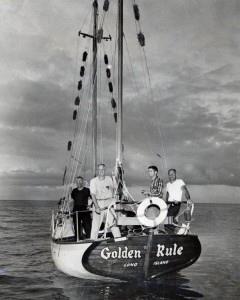

One year after returning to Hiroshima, they also protested against the Soviets’ nuclear testing by sailing their yacht, “The Phoenix”, to Nakhodka carrying protest letters against Russia’s nuclear testing. The USSR, however, rejected their request to dock. After talking with Russian officers, Barbara felt that it would be unnecessary for Americans and Russians to be afraid of each other if they could meet and talk face to face.
2 Peace Pilgrimage
In 1962, one year after returning back to Hiroshima from Russia, Barbara began a Peace Pilgrimage taking along a hibakusha and a young man who was orphaned by the A-bomb. They took the story of Hiroshima’s suffering to 12 countries including the nuclear nations. In 1964 Barbara left with a much larger group of hibakusha, 19 from Hiroshima, 6 from Nagasaki, and interpreters on a World Peace Study Mission. Over a 75-day period they visited eight countries, including countries that had nuclear weapons, and 150 cities.
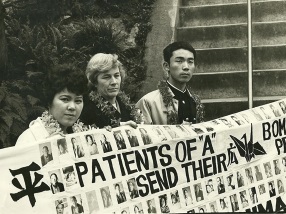

3 World Friendship Center
Barbara Reynolds, together with Dr. Tomin Harada, a Hiroshima surgeon, established World Friendship Center in 1965. It was to serve as a place where visitors from around the world could meet hibakusha, A-bomb survivors, and listen to their testimonies in person. It has been in operation since then as a place to foster peace by building friendship among people. Following Barbara’s inspiration, WFC provides various activities such as hibakusha accounts, peace ambassadors exchange, English classes, Peace Park guided tours, peace seminars, and home-staying experiences for students to study Barbara’s legacy and WFC in English.

4 Honorary Citizen Award Ceremony
In 1969, Barbara returned to the U.S. and devoted herself to helping refugees from Cambodia and Vietnam at her house in Long Beach, Calfornia.
In 1975, she contributed to the peace conference, “Hiroshima and Nagasaki, Thirty Years After” held at the Wilmington College in Ohio. Barbara set up the “Hiroshima-Nagasaki Memorial Collection”, which is a part of the Peace Resource Center (PRC) on the campus of the Wilmington College. In this year, she was awarded the title of Special Honorary Citizen of Hiroshima City for her contribution to the campaign of nuclear weapons abolishment and for letting the world know about “Hiroshima”.
Barbara is “Kashin” or “Goddess of Flowers” according to Dr. Tomin Harada. The term “Kashin” is associated with someone who sows seeds, but lets others enjoy the harvest or results of his/her deeds. Barbara also helped refugees. She remained poor all her life. As a Quaker, Barbara lived with a strong faith and prayer life and acted with a deep love of humanity. She died of a heart attack on February 11, 1990.
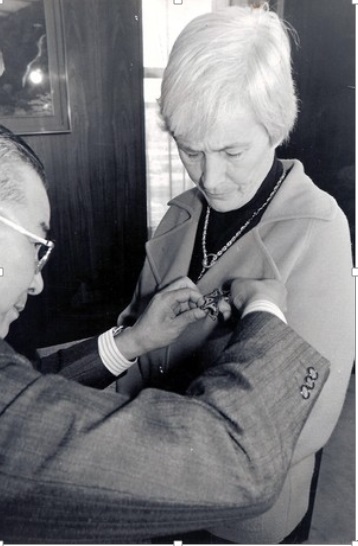
5 Barbara’s Memorial Monument
In June, 2011, an unveiling ceremony of the memorial monument for Barbara Reynolds was held. It was erected in the Peace Memorial Park beside the monument of Norman Cousins and that of Marcel Junod. The inscription, “I, too, am a hibakusha” shows that Barbara always identified herself with hibakusha.

6 Barbara’s Spirit Living Today
Today, World Friendship Center is kept operating as a window to Hiroshima for the people around the world. It is based on the motto, “To foster peace, one friend at a time.”
Since 1965, when WFC was founded, about 40 couples from America have been volunteer directors. Here, people around the world can meet, share experiences, and talk about peace.

Roger &Kathy Edmark
7 Main Activities of WFC
[English Classes]
From Tuesday to Saturday every week, English conversation classes are open to each level of students. For two hours, they can enjoy talking freely with a tea-time in between, or read and study books in English together.
[Hibakusha Testimonies]
WFC accepts overnight guests from around the world, and if they want, they can listen to hibakusha’s A-bomb accounts. Hibakushas talk with a strong wish that nobody else will experience the same suffering as they have. The average age of hibakushas is now over 80, and the chance to listen to their story in person is getting limited. It will be necessary to think of another way to share these stories.
[Peace Park Tour]
We guide guests around the main monuments in the Peace Park in English for about one and a half hours. We have a study meeting for guiding once a month.
[Peace Ambassador Exchange]
PAX is based on the Peace Pilgrimage Barbara did in 1962 and in 1964. At present, we have PAX programs between Japan and the U.S. and between Japan and Korea. Barbara’s idea was that if people meet and talk, mutual understanding and friendship will be born, which will prevent war.

[Mutsumien Visit]
The directors and English class students have been visiting Mutsumien, an A-bomb survivors’ nursing home, once a month on the third Thursday since 1985. We celebrate birthdays of those who were born in that month. Over a year, about 100 residents participate and are very cheerful. They enjoy singing songs, playing games, and chatting with us. Mutsumien is the oldest A-bomb survivors’ nursing home in Japan, built next to Funairi Hospital in 1970.
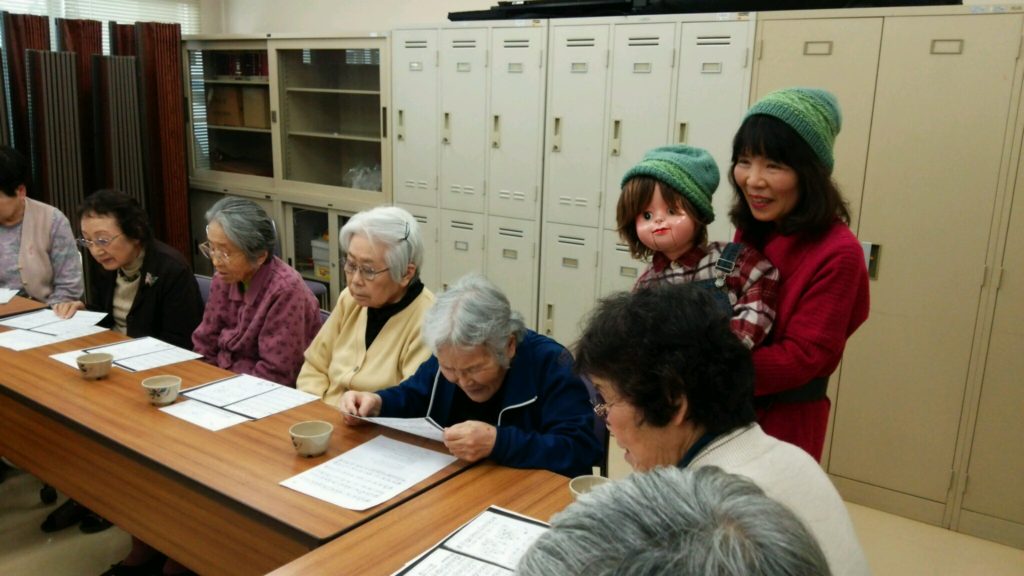
[Study Abroad Experience in Japan]
WFC has a program available for students who like studying English and want to study abroad. They can stay at WFC and learn about Barbara Reynolds and WFC programs for peace. They can experience life while speaking only English in Japan.
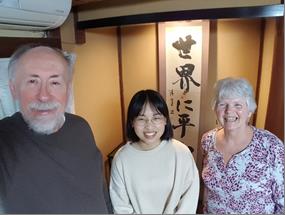
■For more information, please look at the following website.
https://wfchiroshima.com/
The editor: Michiko Yamane, chairperson of NPO World Friendship Center
Reference:
The Phoenix and The Dove written by Barbara Reynolds in 1986
Moments of Peace written by Tomin Harada in 1994
Pilgrimage to Hiroshima written by Mizuhoko Kotani in 1995
Living in Hiroshima written by Tomin Harada in 1999
Source of the photos:
MUM: The Conscience, Courage and Compassion of Barbara Reynolds
June 12, 1915 – February 11, 1990
Tags associated with this article



